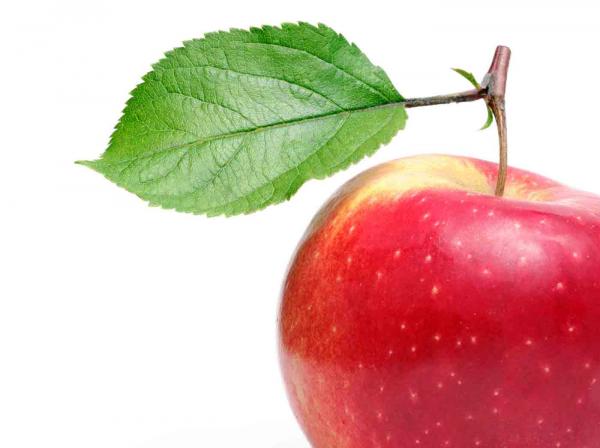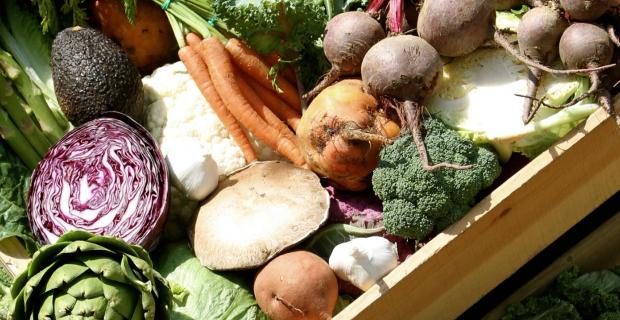Meditations on an Apple

This essay was first presented during a Bioneers conference workshop. Before the meditation, each participant was given a Red Rome Beauty apple.
Here in Northern California, in the early fall, while the leaves are still on the trees and a single frost has not yet touched the field, the apple harvesters are bringing in a treasure.
In a place in the world known as Ladakh, before each meal, members of the community take a moment to close their eyes. In the quiet moment, they give thanks for the meal by picturing the face of each person who contributed to bringing the meal to the table and remembering them.
As you hold the apple, remember that the ancestor of all apple trees arose in southwestern Asia, in Turkmenistan, Uzbekistan, Tajikistan, Afghanistan, and all across the Caucasus Mountains. Protected and nourished by observant stewards for thousands of years through their system of agriculture, their culture of the land, the apple contains their vision. In this moment, remember their contribution and offer your gratitude to these ancestors for their foresight, diligence and skillful means.
The original apple, now called the Siberian Crabapple, has traveled far and wide. Remains of apple trees have been unearthed near lake dwellings in Switzerland, evidence of the western migration of the apple thousands of years ago. The apple was carried, as all food crops have been carried into the world, by helping agents; blown by the wind, caught in the coat of the fox, dropped by the quail and the crow, wrapped safe in the pocket of an adventurer, sewn into the hems of garments by refugees running to safe ground. The apple contains their journeys. In this moment, remember their contribution and offer your gratitude to these many agents of dispersal who carry seed to the four directions.
In our garden at the Center for Ecoliteracy, we tend a small patch of Yugoslavian heirloom beans, a handful of which was brought out of Kosovo to England by refugees. The handful was divided two ways: one portion was left in England, and one portion was carried to America by a traveler. Once here, the half handful was again divided three ways, and 27 beans came to be planted in our little garden. By the time the beans were sprouting, this country was making war on the place where the beans had grown for centuries. We plant them every year, save the seed, and give it away. "As many hands as possible," is the wisest practice for seed savers. We know that somehow the beans will be returned to their home ground when it is safe.
The apple is the oldest of the rose-family fruits, sharing a direct lineage with the pear, the quince, and many other Rosacea ancestors, among them the wild fruits of the woodlands and mountains: alpine strawberry and thorny gooseberry. All apples have a true core. If sliced at the middle latitude, the cut reveals a five-pointed star at the heart of the fruit. In each protected oval chamber of the star rests a sable-colored seed. Apple trees of the past and the future are contained within the apple seed.
The parent of the Red Rome Beauty was known simply as "Rome." Settlers of the Ohio River Valley planted this hearty tree in the 1820s along the northern bank of the Ohio. During the spring, one tree happened to send up a shoot from below the graft — from a part of the tree that is not supposed to bear fruit. Orchardists lop these unwanted shoots off as routinely as they walk the rows. But by a fortunate oversight, this branch survived to bear splendidly colored delicious fruit.
Neighbors recognized it for its beauty and flavor and began to take scions of the branch for propagation on their farms and fields. Over time, the apple became a regionally famous variety named for Rome Township, Ohio. In the great flood of 1884, the waters of the Ohio rose up and washed the parent tree down river. But by then, the Rome Beauty was well established. It continued to be cultivated because of its size, handsome looks and sweet flavor. Generations of skilled orchardists improved the apple's color, size and luster. It became known as the Red Rome. The apple contains the diligence of these homesteaders. In this moment, remember the settlers of the Ohio Valley and the orchardist who allowed an errant branch to flourish. Remember too, the careful and patient endeavors of seed savers, orchard tenders, and livestock breeders who work from a vision they know will not be realized in their lifetime.
Now, in the gathering fall, in the season known as "locking," the apple tree loosens her leaves. All summer long these leaves have been breathing, making sweetness from sunlight, breathing to form the apple in your hand. It takes the work of 40 apple leaves to breathe an apple into life. As they breathe, the apple leaves exhale the moisture drawn up by their roots from deep beneath the soil horizon. A single apple tree, in full growth, returns fifteen tons of transpired water to the atmosphere in one growing season. The apple contains the breath of the apple tree. In this moment, remember to breathe deeply, inhaling and exhaling with the apple tree, air made sweet with apple making. Thank the apple tree that, through the process of life itself, renews the planet and fills our lives with sweetness.
Everywhere, apple leaves are releasing their hold, drifting back to earth to be broken down into richness by the winter rains and the living beings of the soil. In this world beneath our feet, filled with mystery and action, many creatures yet unnamed and uncounted, contribute to our sustenance. We are all dependant on the living soil for our needs. In each crumb of living soil, billions of organisms are growing, reproducing, and dying. The apple contains their lives. In this moment remember the natural cycles of growth and decay and the unseen creators of the skin of the earth, the soil community of bacteria, protozoa and nematoads, the molds, yeasts and fungi, the mites, springtails, and earthworms, the spiders, beetles, and moles.
Lift the apple and breathe in its perfume. Rest the smooth burnished red skin of the fruit on your skin. Imagine the work of the bees, visiting the apple blossoms in spring, reaching into the apple flower to pollinate the fruit you hold. In her lifetime a honeybee produces a teaspoon of honey, each drop carefully stored in the waxy comb. The apple contains the artful bee. In this moment, remember her work in the sweetness of the fruit. Remember too the work of all pollinators; the butterflies, moths, and bats who, in their search for ethereal sweetness, feed us.
These apples were harvested from 22 acres of Red Rome Beauty and Gravenstein apple trees at Flatlands Flower Farm in Sebastopol. Situated seven miles from the ocean, the marine influence is in the air and soil of the farm. Step out onto the front porch of the farmhouse, looking north, and see Mt. St. Helena rising in the distance. Look west to the towering redwoods and ocean tinted sky. Dan and Joanne moved to the orchard four years ago and set about transitioning it to organic in their first year. "We're bringing these trees back," says Dan, "through composting and cover cropping. We'll never go to grapes."
Sara, the orchard manager, tall, with long braided hair, picks and packs the nicest apples each week for the farmers' market and drives the heavy wooden boxes into town. She carefully sets up and tends the little farm stand, tipping the wooden boxes of red and green apples toward the hands of the people walking through the colorful, harvest-lined corridor of shade and sun.
Sara and all farmers, farm workers, assistants, and interns, together with the interested customers and shoppers, are the market. According to ancient agreements, between city folk and country folk, they make the market appear for moments in time, and make it go away. During these moments, the fertility of the earth is exchanged. The apple contains these understandings in exchanges of captured sunlight. In this moment, remember the family farmer who recognizes the value of mature fruit trees and the need to protect and nurture them. Remember also the farm worker who carries the harvest in her arms and the young people who are drawn to farms, to labor and learn.
The apples were brought home from the market. Each one was hand polished, burnishing the natural wax to a fine gloss. Now, the apple rests in your hands. Raise the apple to your lips and taste it. As you do, savor the millions of agreements and simple actions, held in a web of relationships, arrayed across time and space, connecting you to each other and to the land. The apple contains all these. They are its sweetness and beauty. In this moment, remember all that is given to you in the form of this apple and enjoy the fruit of these labors and intentions.




